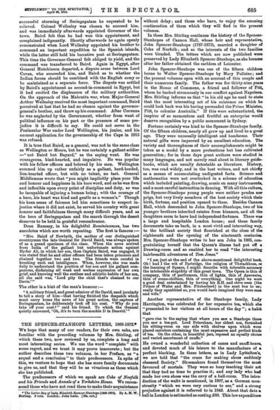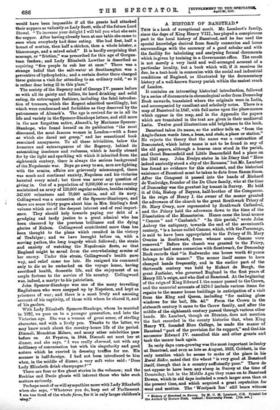THE SPENCER-STANHOPE LETTERS, 1806-1873, WE hope that many of our
readers, for their own sake, are familiar with the preceding volumes by Mrs. Stirling, of which these two, now reviewed by us, complete a long and most interesting series. We use the word " complete " with some regret, and we trust it may prove inaccurate ; but the author describes these two volumes, in her Preface, as "a sequel and a conclusion" to their predecessors. In spite of this, we venture to hope that she has more family documents to give us, and that they will be as vivacious as those which she has published.
The predecessors of which we speak are Coke of Norfolk and his Friends and Annals of a Yorkshire House. We recom- mend those who have not read them to make their acquaintance
• The Letter-Bag of Lady Elisabeth Spencer-Stanluwe (18(6-1873). By A. X. W. Ntirling. 2 vols. London: John Lane, [32s. net.]
without delay ; and those who have, to enjoy the amusing continuation of them which they will find in the present volumes.
In these Mrs. Stirling continues the history of the Spencer- Stanhopes of Cannon Hall, whose heir and representative, John Spencer-Stanhope (1787-1873), married a daughter of Coke of Norfolk ; and so the interests of the two families were blended. The letters which are now published were preserved by Lady Elizabeth Spencer-Stanhope, as she became after her father obtained the earldom of Leicester.
John Spencer-Stanhope was one of the fifteen children borne to Walter Spencer-Stanhope by Mary Pulleine ; and the present volumes open with an account of this couple and their numerous family. The father was for thirty-nine years in the House of Commons, a friend and follower of Pitt, whom he backed strenuously in our conflict against Napoleon. Mrs. Stirling informs us that "in his old age he used to state that the most interesting act of his existence on which he could look back was his having persuaded the Prime Minister, Pitt, to colonize Australia." If this were substantiated, the inspirer of so momentous and fruitful an enterprise would deserve recognition by a public monument in Sydney. Fortune certainly was kind to the Spencer-Stanhope family.
Of the fifteen children, nearly all grew up and lived to a great age. They were unusually intelligent and handsome. Their natural gifts were improved by an excellent education. The variety and thoroughness of their accomplishments might be taken as a model by a more pretentious but less cultivated generation ; for in those days great authors were studied in many languages, and not merely read about in literary guide- books, which are usually detestable as literature. History, too, was read widely, and in the best writers, and not chiefly as a means of accumulating undigested facts. Science and mathematics were not overlooked in a scheme of education which included painting, drawing, music on many instruments, and a most careful instruction in dancing. With all this culture, the Spencer-Stanhope young people were neither prudes nor prigs, but very lively members of the best society which their birth, fortune, and position opened to them. Besides Cannon Hall, which descended to John Spencer-Stanhope, two of his
younger brothers inherited estates from kinsmen, and all the daughters seem to have had independent fortunes. There was a large and hospitable London house ; and these family documents take us back, in a most vivid and interesting way, to the brilliant society that flourished at the close of the
eighteenth and the opening of the nineteenth centuries.
Mrs. Spencer-Stanhope writes to her son John in 1805, con- gratulating herself that the Queen's illness had put off a Drawing-room and so enabled her to read "the interesting hairbreadth adventures of Tom Jones."
"I am just at the end of the above-mentioned delightful book. Oh! had I the wit of Partridge, the religion of Thwackhum, or the learning of Square, I might describe with tolerable accuracy the intolerable stupidity of this great town. The Opera is thin of company, thin of performers, thin of lights, thin of figurantes, thin of scene-shifters, thin of everything. One night we were a good deal entertained by having his R.H. and chere emit [the Prince of Wales and Mrs. Fitzherbert] in the next box to us; really they squabbled so, you would have imagined they were man and wife."
Another representative of the Stanhope family, Lady Harrington, was celebrated for her expensive tea, which she "presented to her visitors at all hours of the day "; a habit that
"gave rise to the saying that where you saw a Stanhope there you saw a tea-pot. Lord Petersham, her eldest son, furnished his sitting-room on one side with shelves upon which were placed canisters containing the most expensive and perfect kinds of tea. On the other, in beautiful jars, reposed an equally choice and varied assortment of snuffs."
He owned a wonderful collection of canes and snuff-boxes, and devoted much of his leisure to the manufacture of a perfect blacking. In these letters, as in Lady Lyttelton's, we are told that "the craze for making shoes suddenly obsessed Society." Shoemakers found themselves the most favoured of mortals. They were so busy teaching their art that they had no time to practise it; and any lady who had made her own shoes was the envy of a ball-room. The intro- duction of the waltz is mentioned, in 1807, as a German mon- strosity "which we were very curious to see," and a strong prejudice against it is referred to in 1843. About that date a ball in London is estimated as costing £80. This low expenditure
would have been impossible if all the guests had attacked their suppers as valiantly as Lady Scott, wife of the future Lord Stowe]. "To increase your delight I will tell you what she eats for supper. After having already been at one table she came to ours when everybody had done eating. She had first, half a breast of mutton, then half a chicken, then a whole lobster, a blancmange, and a mixed salad." It is hardly surprising that massage, or "friction," was prescribed for this age of Gargan- tuan feeders; and Lady Elizabeth Lowther is described as requiring "five people to rub her at once." There was a strange belief that the salt-water at Southampton was a preventive of hydrophobia; and a certain doctor there charged three guineas a visit for attending to an ordinary cold, "so it is rather dear being ill in this place."
The society of the Regency and of George IV. passes before us with all its gaiety and follies, its hard drinking and solid eating, its extravagant fashions, including the fatal introduc- tion of trousers, which the Regent admitted unwillingly, but which were condemned and forbidden as they deserved by the patronesses of Almack'e. The age is revived for us in all its life and variety in the Spencer-Stanhope letters, and still more in the now forgotten satire, Alinack's, by Marianne Spencer- Stanhope, who found herself on its publication "the most -discussed, the most famous woman in London—with a fame at which she dared not grasp," and her sensational book remained anonymous. To all these trivialities, below the humours and extravagances of the Regency, behind its astonishing insolence and rudeness, which is hardly atoned for by the light and sparkling wit which it inherited from the eighteenth century, there is always the serious background of the Napoleonic war. Boys go away to sea, men are fighting with the armies, affairs are grievously mismanaged, there was much and continual anxiety, Napoleon and his victories haunted every mind ; but there was never any question of giving in. Out of a population of 9,000,000 or so the country maintained an army of 120,000 regular soldiers, besides raising Z47,000 volunteers and 78,000 militia, and all its navy. Colliagwood was a connexion of the Spencer-Stanhopes, and there are some thirty pages about him in Mrs. Stirling's first volume which are of the deepest interest and of real import- ance. They should help towards paying our debt of a grudging and tardy justice to a great admiral who has been obscured by the previous brilliance and the dying glories of Nelson. Collingwood contributed more than has been thought to the plans which resulted in the victory of Trafalgar ; and we have brought before us, with a moving pathos, the long tragedy which followed ; the strain and anxiety of watching the Napoleonic fleets, so that England might be saved from the overwhelming armies of her enemy. Under this strain, Collingwood's health gave way, and relief came too late. He resigned his command only to die as he embarked on the voyage home, having sacrificed health, domestic life, and the enjoyment of an ample fortune to the service of his country. Collingwood was, indeed, a martyr to his patriotism.
John Spencer-Stanhope was one of the many travelling Englishmen who were snapped up by Napoleon, and kept as prisoners of war ; and there is a most lively and amusing account of his captivity, of these with whom he shared it, and of his gaolers.
With Lady Elizabeth Spencer-Stanhope, whom he married in 1822, we pass on to a younger generation, and into the Victorian age. She was a woman of great sense, of sterling character, and with a lively pen. Thanks to the latter, we may know much about the country-house life of the period. Disraeli, Monckton Mines, and many other celebrities pass before us. At Fryston, in 1844, Disraeli sat next her at dinner, and she says, "I was really charmed, not with any brilliancy of conversation but with his singularity and good nature which he exerted in dressing truffles for me. His manner is half-foreign. I had not been introduced to him when, in the middle of dinner, a very soft voice said : `Does Lady Elizabeth drink champagne ? ' " There are four or five ghost stories in the volumes ; and the Erskine and Dade ghosts will interest those who take such matters seriously.
Perhaps most of us will sympathize more with Lady Elizabeth when she says, "Whatever you do, keep out of Parliament. I am too tired of the whole farce, for it is only larger children's



























































 Previous page
Previous page